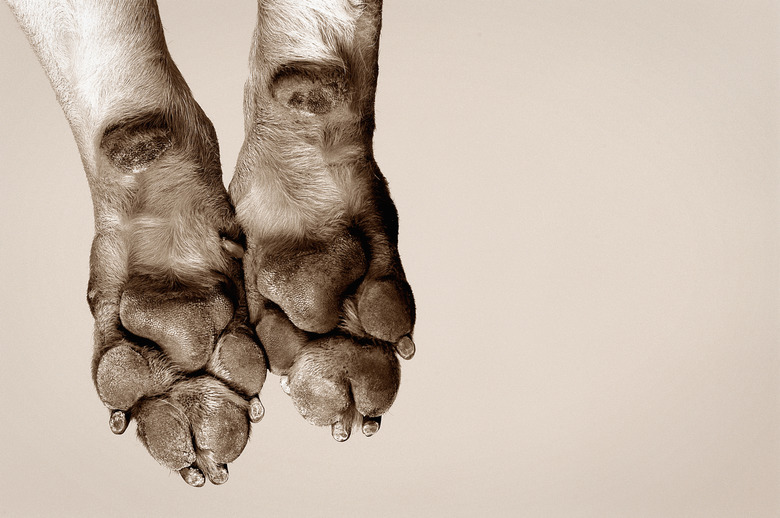What Causes Puppies To Have Black Paws?
Dog paw pads, or toe pads, have evolved to help dogs tolerate a variety of temperatures, protecting them from hot surfaces and ice and snow. However, that doesn't mean they aren't susceptible to either frost bite or burns in extreme temperatures. Paw pads are thick layers of fatty tissue, keratin, and collagen that also offer protection on rough terrain.
A dog's paw pad can be different colors, including black, brown, tan, pink, white, or even gray. Many dogs have multicolored paw pads, though most dogs with white, tan, or black paws also have black paw pads. Puppies are born with pink toe pads that change color, usually around 6 months of age. Paw pads can be sensitive at this stage.
Paw pad color change
It is common for puppy paw pads to be pink or white and gradually change color with age — a process called marbling. However, the color the puppy's paw pad is supposed to be in adulthood is genetically predetermined. Environment or diet plays no role in determining whether your dog has black paws or black paw pads, except when outdoor agents, like mud or grass, discolor or stain a dog's paws over time. Healthy dog paw pads can be a variety of colors but are most often black.
While paw pad color changes in puppies are common, color changes in older dogs can indicate health issues. For example, salt exposure or dryness can turn paw pads white, and so can more severe issues, such as hyperkeratosis; vitiligo, an autoimmune disease; or canine distemper, also called hard pad disease. Allergies, fleas, and frostbite can turn paw pads a swollen pink or red, and yeast infections will turn paws a reddish-brown. The latter requires a medicated shampoo to soak the dog's paws while bathing.
Dog paw moisturizer
Dog paw moisturizer sounds like a good idea but only use it in specific circumstances, such as if your dog's paw pads are cracked or too dry. Even then, don't use human lotions or moisturizers. Ask your vet for recommendations or prescriptions. However, moisturizing paw pads regularly isn't a good idea because soft pads are more likely to tear or puncture. Tougher and thicker paw pads are the goal.
Instead, paw pad wax is good protection against winter salt and excessive cold. Also, there are many dog products specifically formulated to make dog paw pads tougher and more durable. After all, the purpose of canine toe pads is to cushion, protect, and increase traction on a variety of surfaces. Durable paw pads improve a dog's stability.
Dog breeds with rough paws
One of the ways your dog can develop rough paws or thicker paw pads is to use them frequently. For instance, dogs who walk on city pavement or hike often over rocks and woodland detritus will likely develop rougher paw pads than those that walk primarily on softer surfaces or lawns. In fact, it's a good idea to gradually thicken or toughen your dog's paw pads of any color because it makes them less susceptible to cuts or injuries.
Dog breeds with rough paws are usually high-energy breeds. For instance, dog breeds that are natural working dogs, like herding border collies, or gun dogs, like English springers, are more likely to have rough paw pads simply from increased use. Clearly, any dog breed will benefit from regular exercise and so will their paw pads.
